Viewing: Blog Posts Tagged with: child, Most Recent at Top [Help]
Results 51 - 75 of 104
Blog: warrior princess dream (Login to Add to MyJacketFlap)
JacketFlap tags: girl, drawing, sketch, angel, child, heart, heaven, colored pencil, Add a tag
Blog: Darcy Pattison's Revision Notes (Login to Add to MyJacketFlap)
JacketFlap tags: child, kid, parent, how to create, character, characters, Add a tag
When you write kids’ books, there’s often a parent component. Duh. Kids have parents. So what?
Get Rid of Adults
One recommendation for dealing with parents is to get rid of them. Send them out of town for work; get rid of at least one parent through death, divorce or neglect; stick them in the background and barely mention them. There’s good reason to suggest getting rid of parents. After all, a main character MUST solve his/her own problems and a well-meaning parent could ruin your story.
Family Stories
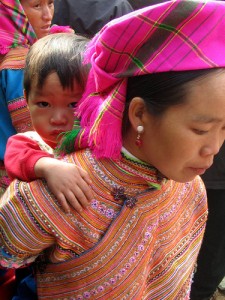 But what if this is a family story? As I said last week, I’m reading through Please Understand Me II: Temperament, Character, Intelligence, a book about the Briggs-Meyers types of personalities and Chapter 8 was an amazing revelation. It’s about Parenting!
But what if this is a family story? As I said last week, I’m reading through Please Understand Me II: Temperament, Character, Intelligence, a book about the Briggs-Meyers types of personalities and Chapter 8 was an amazing revelation. It’s about Parenting!
Personality Type as a Child. It goes through an explanation of how a basic personality type would be played out as a child. An Idealist Child (NF, including INFT, INFP, ENFT, ENFP) would be soulful, emotional and self-examining.
Personality Type as a Parent. Likewise, the parenting style of the different types is explained. An Artisan Parent (SP, including ISPN, ESPN, ISPT, ESPT) has a hands-off style, letting kids learn lessons on their own.
Combination of Parent-Child. What happens when one personality style is in charge of another, like in the parent-child relationship? They might clash, or they might bring out the best in each other. For example an Artisan Parent (SP) and an Idealist (NF) kid is explained like this:
Although they can have some trouble understanding each other, Artisan parents can be valuable models for their Idealist children. NF kids tend to get lost in abstraction and a self-absorbed search for meanings and portents , and the SP’s warm embrace of immediacy can be an important lesson for them. p.277
You may not want to be so strict in figuring out what personality type the parents and kids actually are (though it does help with character development). But it’s interesting reading through the different types of interaction between kids/parents. Of course, this is the “nature” part of the equation and you’ll want to add the “nurture” part through your story.
Personally, I try to get rid of parents. I agree that’s best. But sometimes–often, for me–the story is partly ABOUT that parent-child relationship. Especially for middle grade novels, parents and a kid’s relationship to them is extremely important. In those cases, this is a good resource for figuring out where the conflicts might lie and how to exploit the conflict for an exciting story.
Add a CommentBlog: B is for Books (Login to Add to MyJacketFlap)
JacketFlap tags: Hello, My Name is..., Passport, Please, Samuel Ribeyron, Thao Lam, Gambhiro Bhikkhu, Yllavu, child, children's book, Add a tag
HongFei Cultures, a French publishing house, only publish seven books a year and every one of them is worth checking out (see their backlist on www.hongfei-cultures.com). For Canadian fans, I have been told that HongFei books are distributed by Agence du livre, Quecbec, so if you can’t find them in the bookstores, you can [...]
Add a CommentBlog: Ginger Pixels (Login to Add to MyJacketFlap)
JacketFlap tags: child, postcard, dragon, Ginger Nielson, Add a tag
I decided to create a post card for my fall mailing based on the acrylic painting I made for the NYC library exhibit. I'll try to post a finish in a few days. *:) On the back of the card I will place the rules for
"how to ride a dragon ~ 101."
Blog: Ginger Pixels (Login to Add to MyJacketFlap)
JacketFlap tags: star gazing, illustration friday, ocean, child, Ginger Nielson, moon, stars, Add a tag
Blog: Shari Lyle-Soffe (Login to Add to MyJacketFlap)
JacketFlap tags: Asperger's, service dogs, child, training, Jack Foster, Add a tag
Follow this link to learn about a dog being trained as a service dog for a child with Asperger's. Animals never cease to amaze me because of their devotion and usefulness to humans.
My children's books reflect my love for animals. My newest book Shoo Cat! has a dog and a cat in it and wonderful illustrations by Jack Foster.
Remember to have your pets spayed or neutered to help reduce the number of animals in shelters.
Blog: Ginger Pixels (Login to Add to MyJacketFlap)
JacketFlap tags: flowers, illustration friday, IF, child, Ginger Nielson, Black eyed susan, linked, daisychain, Add a tag
One of the things I like about Illustration Friday is the neat challenge each week brings. And along with it a chance for me to think beyond whatever project on which I am working. This weekly subject brings a break in the concentration of an assignment. I think of it like a recess at grade school. This is a chance to see what will happen if I play with a new idea.
Blog: OUPblog (Login to Add to MyJacketFlap)
JacketFlap tags: Science, child, A-Featured, Medical Mondays, mother, Psychology, play, imaginary, human development, Add a tag

Anthony D. Pellegrini is Professor of Educational Psychology at the University of Minnesota. His book, The Role of Play in Human Development, examines the role of different forms of human play in terms of its phylogenetic history, its ontogenetic development, and possible functions, suggesting that human play represents one way in which experience shapes development. In the excerpt below we learn about the importance of imaginary play.
The transition from solitary to social pretend play is a hallmark of the preschool period, reflecting children’s relatively sophisticated social cognitive and linguistic development… because social pretend play involves, by definition, the communication and coordination of abstract meaning between people, the possibility for ambiguity and the subsequent breakdown of social interaction around a pretend theme is relatively high. This state of affairs is why social pretend play has been afforded such an important role in the ontogeny of children’s theory of the mind (e.g., Leslie, 1987). With both social pretend play and theory of mind, children are concerned with others’ intents and beliefs. Also in both theory of mind and social pretend play research, the role of the close adult-child relationship, such as the mother-child relationship, is central to children’s developing ability to understanding others’ intentions…
There is also a very good biological reason for mothers to spend time in joint interaction with their infants and children. Mothers are “motivated” to spend time and energy on their offspring because they represent a major genetic investment. Her offspring contain 50% of her genes, and the mother wants to maximize the survival and reproduction of her offspring, and her genes… Therefore, mothers not only invest in protecting and provisioning their offspring, but also in tutoring them in the skills necessary to maximize the offspring’s survival and reproduction. Mother-child playful interactions are part of this process…
The offspring, too, have an interest in maintaining a close relationship with their mothers, providing their mothers are responsive to their needs. That is, offspring depend on mothers for protection and provisioning, and they try to maximize the resources they extract from their mothers… This dynamic relationship of interdependence is enacted in the mother-child attachment relationship. This relationship is developed in social pretend play and forms an important base of children’s representations of other social relationships. This developmental progression has been documented in a series of studies by Carolee Howes (1992) and her students. According to Howes, children’s social pretend with mothers begins at around 12 to 15 months of age when children take pretend play actions outside their functional context (i.e., decontextualization), such as pretending to drink from an empty cup. In a mother-child interaction context, mothers will structure pretend scenarios to maximize children’s participation…, because the child is now capable of responding to its mother’s pretend initiations, often by watching, complying with, and imitating those acts. To maximize children’s participation, mothers monitor their children’s behavior closely, being particularly vigilant around pretend behavior; they look at children closely and smile after children’s pretend play acts… In this way children learn to recognize preten
Blog: Ginger Pixels (Login to Add to MyJacketFlap)
JacketFlap tags: IF, child, Ginger Nielson, mud, ducks, muddy, Add a tag
Blog: Watercolor Wednesdays (Login to Add to MyJacketFlap)
JacketFlap tags: daydream, Cheryl McMickle, goauche, child, moon, watercolors, Add a tag
Hello everybody!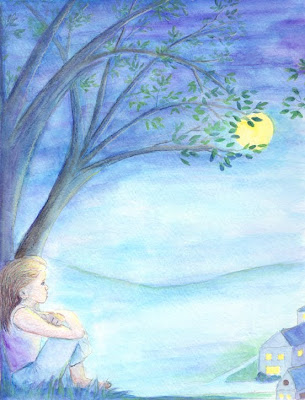
Have I missed WaWe. Hope everyone is having an awesome new year.
This is an illustration I just finished for one of Jennifer Poulter's poster poems. The inner me was always daydreaming and trying to work out the world in my mind.
Goauche and coloring pencil.
Blog: Ginger Pixels (Login to Add to MyJacketFlap)
JacketFlap tags: child, Ginger Nielson, cat, snail, vegetable garden, focused, Add a tag
Blog: Picture Bookies Showcase (Login to Add to MyJacketFlap)
JacketFlap tags: animals, child, Ginger Nielson, peaceful planet, Add a tag
Blog: Darcy Pattison's Revision Notes (Login to Add to MyJacketFlap)
JacketFlap tags: children, marketing, kids, book trailers, child, children's book, elementary, toddler, trailer, preschool, Add a tag
Toddler, Preschool, Elementary Book Trailers
Book trailers for kids, ages 1-10 or so, vary from those for other audiences. The audience for children’s literature is both adults and kids, because adults often hand a book to the kids. The parent, teacher, educator, friend, family member or other adult is the gate-keeper to the book; book trailers must appeal to them. In fact, I wonder if a young child would ever see a book trailer.
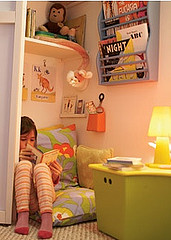
I’m looking for great examples of book trailers for kids. If you have a book trailer or know of a great book trailer for the preschool to elementary audience, please leave a link to it in the comments. I’ll collect these into a new post in a couple weeks. This is a great chance to get your trailers listed in yet another place! Or to help a friend by listing his/her trailer.
Any comments about what makes a good book trailer for kids, or why this particular one is so great, would be interesting, too.
Related posts:
Blog: Darcy Pattison's Revision Notes (Login to Add to MyJacketFlap)
JacketFlap tags: child, kid, write, children's picture book, morals, how to, messages, picture books, ABC, Add a tag
Ebook: How to Write a Children’s Picture Book
It started out as 30 Days to a Stronger Picture Book. But now, (drum roll, please), it’s an Ebook. Expanded from it’s original format, it now includes new sections on writing rhymed verse for a picture book, and many examples of different types of texts.
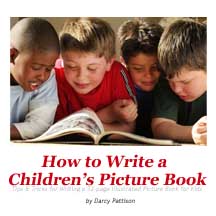
How to Write a Children’s Picture Book includes 36 self-paced lessons on every aspect of writing, editing and selling your children’s picture book.
Basics of Writing a Children’s Picture Book
Start your journey toward publishing by studying the basics of children’s picture books: number of pages, word count, audience, setting, characters, words, messages, morals, themes, voice and more.
The Unique Writing Process for a Children’s Picture Book
Once you understand the basic structure of a children’s picture book, it’s time to choose a topic and write your first draft. Learn topics to avoid and perennial topics. Special techniques for editing your picture book manuscript are also covered.
Typical Picture Book Genres
If you want to write a specific type of children’s picture book, you’ll find tips here for humor, rhyming text, poetry collections, picture book mystery, picture book biography, creative non-fiction picture book, and the ABC picture book.
How to Submit Your Children’s Picture Book
Your story is done? Learn the biggest mistake people make when submitting to a children’s book publisher and how you can avoid it. How do you find the name of an editor? What about self-publishing?
Download your pdf immediately.
Order NOW!
Related posts:
Blog: Ginger Pixels (Login to Add to MyJacketFlap)
JacketFlap tags: child, Ginger Nielson, elephants, fruit, market, skinny, early morning, Add a tag
Blog: blog 30 x 30 - Chuck Dillon's blog. (Login to Add to MyJacketFlap)
JacketFlap tags: autumn, kite, child, Add a tag
Blog: Ginger Pixels (Login to Add to MyJacketFlap)
JacketFlap tags: multicultural, child, Ginger Nielson, boy and tree, Add a tag

Blog: Ginger Pixels (Login to Add to MyJacketFlap)
JacketFlap tags: flower, bee, eye view, child, Ginger Nielson, Add a tag
I spent so much time being awake thinking of this image, that it was the first thing I did in the studio today.
I am sure that happens to many of my illustrator friends. You just can't let it go and it nags at you until you
give the image some time. Here is the rough sketch and the image.

Blog: Lori Calabrese Writes! (Login to Add to MyJacketFlap)
JacketFlap tags: child, Children's Book News, Add a tag
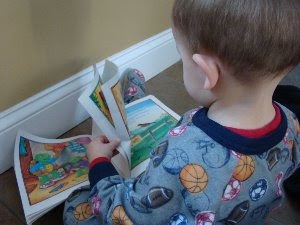
Helping your child learn to read is a partnership that will pay off for a lifetime. Although reading and writing abilities continue to develop throughout life, the early childhood years - from birth through age eight - are the most important period for literacy development. Many people wonder when a child learns to read. Most would answer kindergarten or first grade, but the truth is children start down the road to reading as soon as they are born.
The development of early literacy skills through early experiences with books and stories is critically linked to a child's success in learning to read. That's why children's books need to provide both the stories children enjoy and the structure they need to read fluently and independently.
You can prepare your child to read by sharing your time, talking about the world around you, telling and reading stories and asking and answering questions.
Here are suggestions for helping your child before, during, and after reading:
1. Make reading fun. Read to your child in a comfortable place. Have her sit on
your lap or next to you so that she can see and point to the print and the pictures.
2. Show enthusiasm as you read with your child. Read the story with expression, almost as though you're acting the story out on a Broadway stage. You can make the story more interesting by talking as the characters would talk, making sound effects, and making expressions with your face and hands.
3. Read to your child often. Set aside special times for reading each day, maybe after lunch and at bedtime. The more you can read to him or her, the better—as long as he/she is willing to listen. Reading times can be brief, about 5 to 10 minutes.
4. Look at the cover together and ask your child to predict what the story is about.
5. Encourage your child to chime in with familiar words and phrases.
6. Echo read with your child by reading a line first and having your child read it after you do.
7. Encourage your child to use phonics skills to sound out new words.
8. Provide the word for your child when more assistance is needed so that he or she does not struggle and the experience of reading with you is a positive one.
9. Encourage your child to read the books over and over again. Have him or her read to brothers, sisters, grandparents, and even stuffed animals. Repeated readings develop confidence in young readers.
10. Talk about the stories. Ask and answer questions. Share ideas about the funniest and most interesting characters and events in the stories.
Even six-week-old babies like the feeling of closeness when a parent,grandparent, or other caretaker reads to them. When children find out that reading can be a warm, happy experience, they begin to build a lifelong love of reading.
Blog: Bobo's Fun Place (Login to Add to MyJacketFlap)
JacketFlap tags: Child, Cat, Children Art, Bobo Cat, 童画, Illustration, Illustration Friday, Add a tag
Blog: Picture Bookies Showcase (Login to Add to MyJacketFlap)
JacketFlap tags: child, Ginger Nielson, fishing, dreaming, Father's Day, drifting, Add a tag
Blog: Darcy Pattison's Revision Notes (Login to Add to MyJacketFlap)
JacketFlap tags: characters, child, baby, suspense, how to write, tragedy, write a novel, symbolism, jeopardy, character's death, death scene, emotional depths, fully characterized, Add a tag
Does Your Story Need a Tragic Death?
A friend was talking to me about stories in which a child dies. he asked, “Is a child’s death in a novel just a cheap narrative device?”
Well, it depends.
- Depth of Characterization. How well do we know the character? Do we know and care for the child? Does the story involve the child and his/her hopes dreams in any way? If we care for a character, we’ll be more likely to be emotionally affected by the death; and it will seem more like a part of the story and not just a cheap narrative device.
- Minor v. Major characters. If a minor child character dies, a throw-away character, the audience won’t care much, unless you’ve given the character big eyes with long eyelashes. But even that bit of specificity in the middle of a scene might not make the reader care. Because it’s a kid, it may be worth some shock value, and killing a kid simply for shock value does count as a cheap narrative trick.
- Suffering, jeopardy, suspense. Has the character suffered or does this come out of nowhere? Orson Scott Card talks about jeopardy, putting a character into a position where there is danger, and suspense, holding back only what happens next. It may be enough to put a child in increasing jeopardy, where things are dangerous, but the character must still act. Or, it may be enough to built a suspenseful scene where we worry about what happens next. Some death scenes could be replaced with either of these and still be effective
- Symbolism of a child’s death. Does the death of a child represent the loss of innocence and faith in the future? Depends. How did you set up the symbolism of THIS child? I don’t think you can generalize here, because the language used to describe the child, the actions of the plot – these can all affect symbolism. To say that a child’s death always equals loss of innocence is too glib an answer.
- Author’s Tolerance for Death. When Leslie dies in Bridge to Terabithia, it’s tragic and awful; I didn’t feel like the author had tried to manipulate my feelings, it was just a horrible accident. But I once went to a conference where an author was talking about the death of a child when it occurs in a story. The author said she hated going to schools, where kids would inevitably ask, “Why did so-and-so have to die?”
Tired of the plaintive question, she decided to never write another story for kids in which a child died. She was in the process of writing a story where a baby was sick and in the hospital. With her decision made, she started working on the next chapter and wrote, “The baby opened her eyes.”
Was she protecting herself from the questions? Was she protecting her audience from the emotional depths to which stories can take a reader? Was she protecting the baby? I don’t know.
In the end, you have to decide where you and your stories will fall: will you allow tragedies, even to the point of death; or will you hold back to protect yourself, your readers and your characters? What does the story tell you to do?
Post from: Revision Notes Revise Your Novel! Copyright 2009. Darcy Pattison. All Rights Reserved.
No related posts.
Blog: Corazonadas (Login to Add to MyJacketFlap)
JacketFlap tags: child, Things that make my corazon jump., Add a tag
Blog: Ginger Pixels (Login to Add to MyJacketFlap)
JacketFlap tags: child, Ginger Nielson, garden, cat, dummy, Add a tag
Blog: Monday Artday (Login to Add to MyJacketFlap)
JacketFlap tags: LittleMissMachete, child, dancing, Add a tag
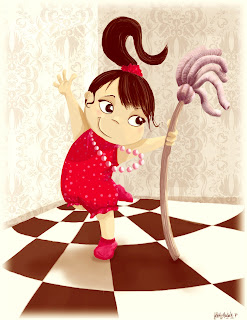
This is my first time posting here and I'm very excited!
When I was 8 (and way younger... and older too) I used to put on my mom's necklaces, grab my faithful and always loving handsome partner (Mr. Mop) and hit the stage (our living room) to dance as if no one was watching (literally).
I miss him. We were a TERRIFIC couple!
I wonder if he still dances... (I must confess, Mr. Swiffer is not as skilled a dancer as Mr. Mop.)
Comments are always welcome and check out my website: www.littlemissmachete.ca or drop by my blog.
Cheers!
View Next 25 Posts





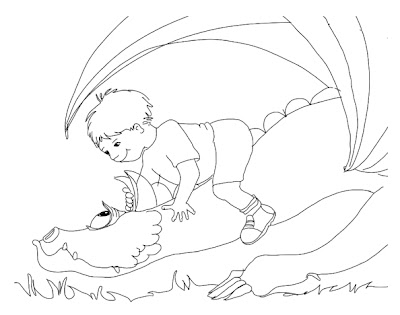

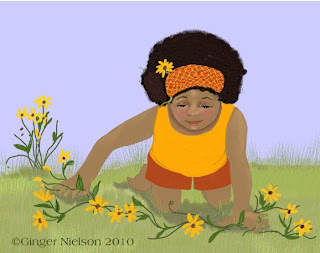


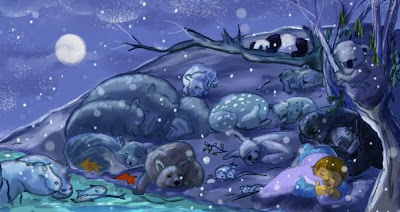





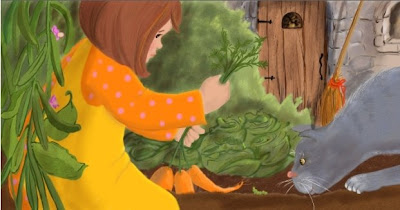
Oh Sara! this is such a beautiful drawing.
Teresa x
I love your line work. Will you be adding color to this piece?